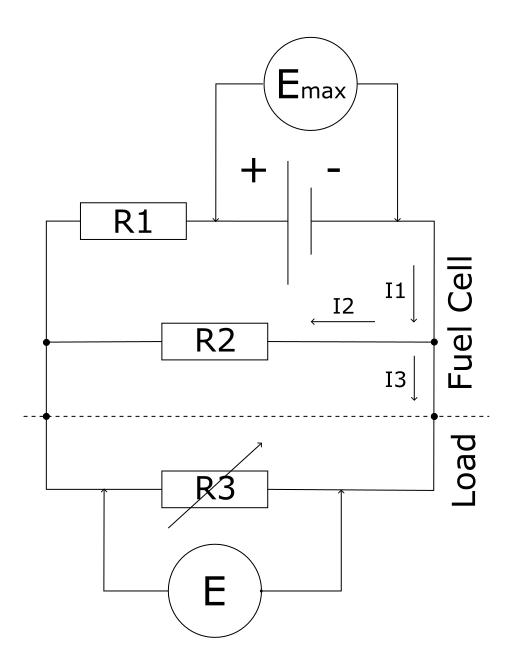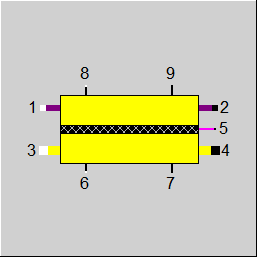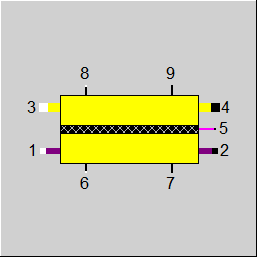

|
Line connections |
|
|
|
1 |
Fuel inlet |
|
|
2 |
Fuel outlet |
|
|
3 |
Oxydant inlet |
|
|
4 |
Oxydant outlet |
|
|
5 |
Electrical outlet |
|
|
6 |
Heating inlet |
|
|
7 |
Cooling outlet |
|
|
8 |
Control inlet |
|
|
9 |
Data outlet |
|
General User Input Values Characteristics Lines Physics Used Displays Example
Component 163 represents a fuel cell. Currently 3 different ion transport types are implemented: O-- , H+ and OH-
|
O-- |
e.g. SOFC |
|
|
H+ |
e.g. PEM |
|
|
OH- |
e.g. AFC |
|
|
FTYPE |
Flag for the fuel cell electrolyte type: =0: O-- transport (SOFC) =1: H+ transport (e.g. PEM) =2: OH- transport (e.g. AFC) |
|
CELLAREA |
Cell Area |
|
NCELLSPERSTACK |
Number of cells per stack |
|
NSTACKS |
Number of Stacks |
|
TEMP |
Operating Temperature |
|
FCURRENT |
Flag for cell current settings: =0: Use value CURRENT =1: Set by port 8 M |
|
CURRENT |
Cell Current |
|
FLOSSES |
Flag for electrical losses method: =0: Use curve CUI and reference fluid concentrations =1: Use data for ohmic and activation losses |
|
AN_H2_REF |
Anode reference H2 molar concentration |
|
AN_H2O_REF |
Anode reference H2O molar concentration |
|
CAT_O2_REF |
Cathode reference O2 molar concentration |
|
CAT_H2O_REF |
Cathode reference H2O molar concentration |
|
T_REF |
Reference Temperature |
|
P_REF |
Reference Pressure |
|
FOHMICLOSSES |
Flag for ohmic losses: =1: Set conductivities =2: Overall definition =3: Detailed layer definition |
|
SIGMA_I |
Ionic coductivity per area |
|
SIGMA_E |
Electronic conductivity per area |
|
FSIGMA_I |
Flag for ion conductivity definition: =0: Sigma=K/T*exp(-Ea/(RT)) =1: Sigma=K*exp(-Ea/(RT)) |
|
K_SIGMA_I |
Ion conductivity K |
|
EAR_SIGMA_I |
Ion conductivity Ea/R |
|
FSIGMA_E |
Flag for electron conductivity definition: =0: Sigma=K/T*exp(-Ea/(RT)) =1: Sigma=K*exp(-Ea/(RT)) |
|
K_SIGMA_E |
Electron conductivity K |
|
EAR_SIGMA_E |
Electron conductivity Ea/R |
|
EL_D |
Electrolyte thickness |
|
EL_FSIGMA_I |
Flag for electrolyte ion conductivity definition: =0: Sigma=K/T*exp(-Ea/(RT)) =1: Sigma=K*exp(-Ea/(RT)) |
|
EL_K_SIGMA_I |
Electrolyte ion conductivity K |
|
EL_EAR_SIGMA_I |
Electrolyte ion conductivity Ea/R |
|
EL_FSIGMA_E |
Flag for electrolyte electron conductivity definition: =0: Sigma=K/T*exp(-Ea/(RT)) =1: Sigma=K*exp(-Ea/(RT)) |
|
EL_K_SIGMA_E |
Electrolyte electron conductivity K |
|
EL_EAR_SIGMA_E |
Electrolyte electron conductivity Ea/R |
|
CAT_D |
Cathode thickness |
|
CAT_FSIGMA_E |
Flag for cathode electron conductivity definition: =0: Sigma=K/T*exp(-Ea/(RT)) =1: Sigma=K*exp(-Ea/(RT)) |
|
CAT_K_SIGMA_E |
Cathode electron conductivity K |
|
CAT_EAR_SIGMA_E |
Cathode electron conductivity Ea/R |
|
AN_D |
Anode thickness |
|
AN_FSIGMA_E |
Flag for anode electron conductivity definition: =0: Sigma=K/T*exp(-Ea/(RT)) =1: Sigma=K*exp(-Ea/(RT)) |
|
AN_K_SIGMA_E |
Anode electron conductivity K |
|
AN_EAR_SIGMA_E |
Anode electron conductivity Ea/R |
|
IC_D |
Interconnect thickness |
|
IC_FSIGMA_E |
Flag for interconnect electron conductivity definition: =0: Sigma=K/T*exp(-Ea/(RT)) =1: Sigma=K*exp(-Ea/(RT)) |
|
IC_K_SIGMA_E |
Interconnect electron conductivity K |
|
IC_EAR_SIGMA_E |
Interconnect electron conductivity Ea/R |
|
FACTLOSS |
Flag for activation losses calculation mode: =0: No activation losses =1: Butler Volmer equation |
|
AN_ACT_K |
Anode K [Jref=yH2*yH2O*K*exp(-Ea/(R*T))] |
|
AN_ACT_EA |
Anode Ea [Jref=yH2*yH2O*K*exp(-Ea/(R*T))] |
|
CAT_ACT_K |
Cathode K [Jref=pow(yO2,0.25)*K*exp(-Ea/(R*T))] |
|
CAT_ACT_EA |
Cathode Ea [Jref=pow(yO2,0.25)*K*exp(-Ea/(R*T))] |
|
FDIFFLOSS |
Flag for diffusion loss calculation mode: =0: No diffusion losses =1: Calculate diffusion losses |
|
EPOR |
porosity |
|
ETORT |
tortuosity |
|
CHH |
channel height |
|
DPOR |
pore diameter |
|
FDEGRADATION |
flag for degradation Mode: =0: No degradation =1: Use Value AREAFRACTION =2: Use charline CDEGRADATION =3: Use expression EAREAFRACTION |
|
AREAFRACTION |
Active Area Fraction |
|
EOHOURS |
Equivalent Operating Hours |
|
EAREAFRACTION |
Expression for active area fraction |
The parameters marked in blue are reference quantities for the off-design mode. These are calculated and entered here during the design calculation of EBSILON®Professional.
Generally, all inputs that are visible are required. But, often default values are provided.
For more information on colour of the input fields and their descriptions see Edit Component\Specification values
For more information on design vs. off-design and nominal values see General\Accept Nominal values
|
NAME |
X |
Y |
|
CUI |
Current density |
Voltage |
|
CDEGRADATION |
Equivalent operating hours |
Active area fraction |
|
PEL |
Electrical Power |
|
U |
Voltage |
|
I |
Current |
|
FU |
Fuel utilization (also on Port 9 M) |
|
OU |
Oxygen utilization (also on Port 9 P) |
|
AREA |
Total area |
|
ADEGRAD |
Effectve area degradation |
|
AREA_EFF |
Effectve area |
|
NCELLS |
Total number of cells |
|
PELCELL |
Cell power |
|
UCELL |
Cell voltage |
|
ICELL |
Cell current |
|
JCELL |
Cell current density (also on Port 9 H) |
|
SIGMA_I_CELL |
Ionic coductivity per area |
|
SIGMA_E_CELL |
Electronic conductivity per area |
The electrical model takes also into account the losses due to electronic conductivity of the electrolyte (especially SOFC) and results in the following block diagram:

| Emax | Electrochemical potential |
| E | Potential at the stack terminals |
| 1/R1 | Electrolyte ionic coductivity, electrode conductivity, etc |
| 1/R2 | Electrolyte electronic conductivity |
| R3 | Electrical load resistance |
| I1 | ion current through elextrolyte |
| I2 | electronic (loss) current through electrolyte |
| I3 | load current at stack terminals |
The thermodynamic model is zero-dimensional, i.e. there is no temperature profile or concentration profile between inlet and outlet. The temperature is considered to be constant and for the concentrations an average between inlet and outlet is taken.
The model allows different level of details for the current-voltage characteristic of the stack:
- user defined curve
- set the overall conductivities for 1/R1 and 1/R2
- set temperature dependent overall conductivites for 1/R1 and 1/R2
- set temperature dependent conductivites for each layer and calculate R1 and R2 from those
Emax will be calculated with the Nernst-equation. For the reaction
(Ox) a A + b B + ... <=> c C + d D + ... (Red)
the potential E for a temperature T can be calculated by
Emax(T) = E0 - (RT)/(zF)*ln((aCc*aDd)/(aAa*aBb))
E0 = ΔG0/(RT)
| A, B, C, D | Component A,B,C,D in the reaction |
| a,b,c,d | Stoechiometric coefficients of the components in reaction |
| E0 | reference potential |
| Emax(T) | Current potential at temperature T for given activities of A,B,C,D |
| aA, aB, aC, aD | activities of components A,B,C,D |
| ΔG0 | Gibbs free energy of the reaction at reference conditions (activity=1, p=pref) |
| z | electrons taking part in the redox reaction |
| F | Faraday constant |
| R | Gas constant |
| T | Temperature |
If FLOSSES is set to curve mode, all losses are derived directly from the curve. for a given current density a curve lookup will be made and via the Nernst-equation, Emax for the reference fluid is calculated. The difference is conidered as the losses to apply at current conditions
In non-curve mode, Emax will be reduced by activation- and diffusion-losses if desired
The activation losses will be calculated by the Butler-Volmer-equation and for the diffusion losses a pore diffusion model for the anode and cathode side is used.
The diffusion losses are calculated with the help of the Nernst-equation for the reduced reactand concentrations due to the modeled transport effects.
The ohmic lossses will be calculated according to the setting of FOHMICLOSSES. If temperature dependent behavior is selected, an arrhenius formulation for the conductivity is used.
Degradation is modeled by reducing the active stack area, which results in an increase of current density and therefore an increase of the losses. The reduction of the active area is modeled with a characteristic curve CDEGRADATION which models equivalent operating hours vs. active area fraction.
|
H5 = Pel |
Electrical Power |
|
P5 = U |
Voltage |
|
M5 = 0 |
DC |
|
H2-H1 = dH_anode |
|
|
M2-M1 = dM |
|
|
P2-P1 = 0 |
|
|
H4-H3 = dH_cathode |
|
|
M4-M3 = -dM |
|
|
P4-P3 = 0 |
|
|
H7-H6 = Q_react |
|
|
M9 = FU |
Fuel utilization |
|
P9 = OU |
Oxygen utilization |
|
H9 = JCELL |
current density |
 |
Display Option 1: Fuel Cell |
 |
Display Option 2: Fuel Cell |
Click here >> Component 163 Demo << to load an example.